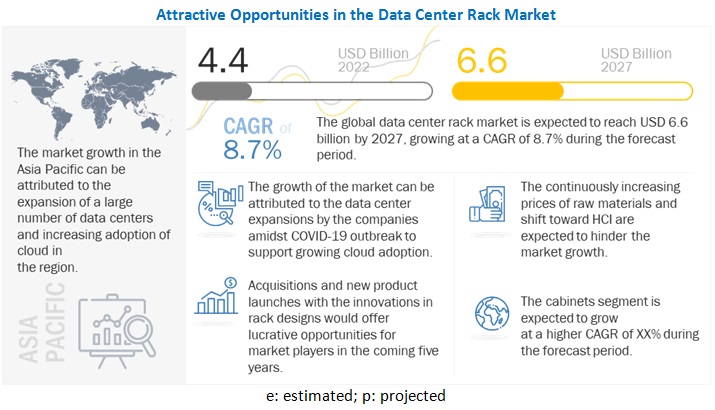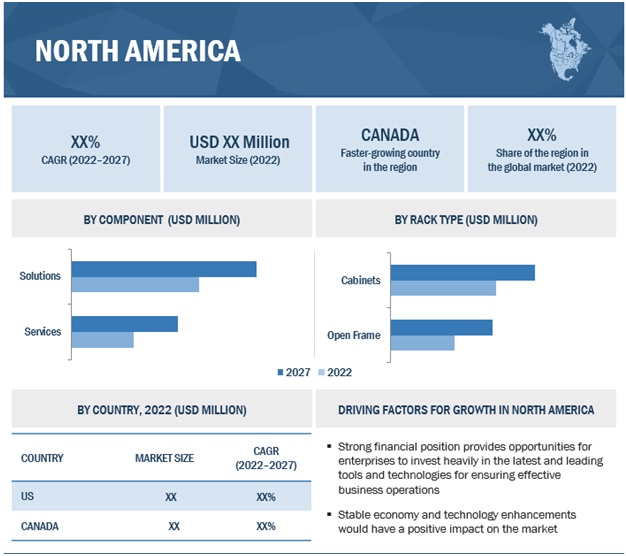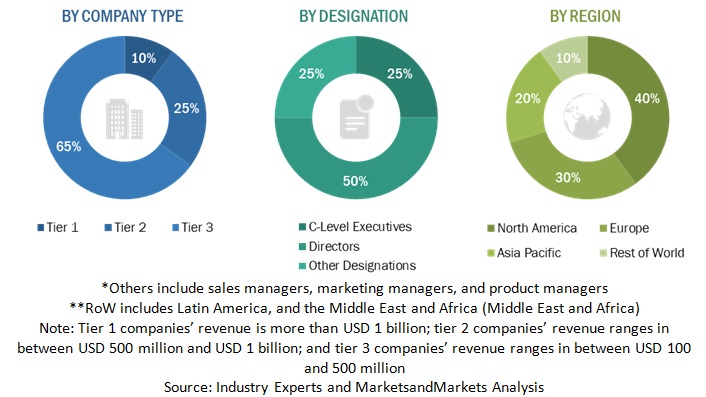Data Center Rack Market by Component (Solutions and Services), Rack Type (Open Frame and Cabinets), Rack Height, Rack Width, Data Center Size (Small and Mid-sized Data Centers and Large Data Centers), Vertical and Region - Global Forecast to 2027
Data Center Rack Market Overview, Industry Share and Forecast
The global Data Centre Rack Market size as per revenue was worth approximately $4.4 billion in 2022 and is poised to generate a revenue around $6.6 billion by the end of 2027, projecting a CAGR of 8.7%.
Factors driving the data center rack market growth include adoption of durable racks, surge in deployment in colocation or data center whitespace facilities, increasing server density, higher data center investments and adoption of the data center rack architecture, need for incorporating Software-defined Data center (SDDC) in order to handle network services efficiently, data center optimization initiative(s) adopted to address critical infrastructure inefficiencies, are few major driving forces expected to create ample opportunities for data center rack vendors.

To know about the assumptions considered for the study, Request for Free Sample Report
Data Center Rack Market Growth Dynamics
The 43U to 52U rack height segment to hold the highest CAGR during the forecast period
Due to rising space constraints across organizations, rack sizes have increased to accommodate a greater number of racks. The adoption of 48U racks is expected to drive the growth of this section. 45U racks are also expected to contribute to the growth of this segment significantly. 47U racks are compatible with most of the server brands. These taller racks provide the flexibility to house both tower and 19 inch rack-mount servers in the same unit. The taller racks provide better ventilation and extra space for cable management.
The small and mid-sized data centers segment to grow at higher CAGR during the forecast period
Data centers with only 20,000 square feet and below of computing space are considered under this segment. These data centers usually hold anywhere between 1 to 800 racks. Small and mid-sized data centers are driven by the need to make optimum use of their existing data center space. Organizations are shifting to high-density data centers that can serve higher data loads by packing multiple servers in a constrained space. However, high-density facilities need specialized enclosures to support their additional cooling needs. The need for specialized rack enclosures is expected to drive the adoption of data center rack solutions in small and mid-sized data centers.
The Consumer and Retail vertical to grow at highest CAGR during the forecast period
The retail sector is characterized using large data center facilities. It has emerged as a data-intensive sector due to the evolving need for maintaining customers’ personal, financial, and stock data. This sector has witnessed a surge in the number of data centers, which has led to increasing demand for efficient data centers. With the advent of online shopping, retailers are adopting more innovative technologies, such as cloud computing, big data analytics, digital stores, and social networks to serve their customers better. Major retailers, such as Amazon and Alibaba, are increasingly deploying hyperscale data centers to support huge data demands. Such a surge in hyperscale data centers is expected to further drive the demand for data center racks. Retailers also adopt colocation services to move their data to remote locations and focus on increasing customer demands.

To know about the assumptions considered for the study, download the pdf brochure
North America to hold the largest market size during the forecast period
The global data center rack market by region covers five major geographic regions: North America, Asia Pacific (APAC), Europe, Middle East and Africa (MEA), and Latin America. North America is expected to account for the largest market size during the forecast period due to the presence of a large number of data center facilities and availability of advanced infrastructure in the region. Demand for optimum space utilization and an indispensable need for better performance is expected to increase the demand for data center racks. A strong economic landscape, huge IT budgets, high technology assimilation, and the early adoption of advanced technologies, such as edge computing, High performance computing (HPC), and AI, are expected to boost the demand for data center solutions and services across North American enterprises.
Data Center Rack Companies
The major players in the data center rack market are Schneider Electric (France), HPE (US), Rittal (Germany), IBM (US), Cisco (US), Fujitsu (Japan), Eaton (Ireland), Dell (US), Vertiv (US), AGC Network (India), Legrand S.A. (France), Oracle (US), Belden (US), nVent (UK), Panduit (US), Great Lakes Data Racks & Cabinets(US), Tripp Lite (US), IMS Engineered Products (US), Rahi Systems (US), and Chatsworth Products (US). The study includes an in-depth competitive analysis of these key players in the data center rack market with their company profiles, recent developments, and key market strategies.

Want to explore hidden markets that can drive new revenue in Data Center Rack Market?
 Scope of the Report
Scope of the Report

Want to explore hidden markets that can drive new revenue in Data Center Rack Market?

|
Report Metrics |
Details |
|
Market Size Value in 2022 |
$4.4 billion |
|
Revenue Forecast Size in 2027 |
$6.6 billion |
|
Growth Rate |
8.7% CAGR |
|
Market Growth Drivers |
Need for computing capacity, driven by the large scale move to working from home |
|
Key Market Opportunities |
Increasingly working towards developing enhanced servers that can withstand harsh environments & Applications in various industries, including military, oil and gas, shipping, aeronautics |
|
Market size available for years |
2018–2027 |
|
Base year considered |
2021 |
|
Forecast period |
2022–2027 |
|
Forecast units |
USD million/billion |
|
Market Segmentation |
Component, Services, Rack Type, Rack Height, Rack Width, Data Center Size, Vertical, and Region |
|
Geographies covered |
North America, APAC, Europe, Latin America, and Middle East and Africa |
|
Data Center Rack Companies in Data Center Rack |
Schneider Electric (France), HPE (US), Rittal (Germany), IBM (US),Cisco (US), Fujitsu (Japan), Eaton (Ireland), Dell (US), Vertiv (US), AGC Network (India), Legrand S.A. (France), Oracle (US), Belden (US), nVent (UK), Panduit (US), Great Lakes Data Racks & Cabinets(US), Tripp Lite (US), IMS Engineered Products (US), Rahi Systems (US), and Chatsworth Products (US) |
This research report categorizes the data center rack market based on component, rack type, rack height, rack width, data center size, vertical, and region.
Based on component, the data center rack market has been segmented as follows:
- Solutions
- Services
Based on services, the market has been segmented as follows
• Design and Consulting
• Installation
Maintenance and Support
Based on rack type, the data center rack market has been segmented as follows:
- Open Frame
- Cabinets
Based on rack height, the market has been segmented as follows:
- 42U and Below
- 43U up to 52U
- Above 52U
Based on rack width, the data center rack market has been segmented as follows:
- 19 Inch
- 23 Inch
- Others (24 Inch and 28 Inch)
Based on data center size, the market has been segmented as follows:
- Small and Mid-sized Data Centers
- Large Data Centers
Based on vertical, the data center rack market has been segmented as follows:
- Banking, Financial Services, and Insurance (BFSI)
- IT and Telecom
- Government and Defense
- Retail
- Manufacturing
- Healthcare
- Energy and Utilities
- Others (Media and Entertainment, and Transportation and Logistics)
Based on region, the data center rack market has been segmented as follows:
-
North America
- United States (US)
- Canada
-
Europe
- United Kingdom (UK)
- Rest of Europe
-
APAC
- China
- Rest of APAC
-
Middle East and Africa
- South Africa
- Rest of Middle East and Africa
-
Latin America
- Brazil
- Rest of Latin America
Recent Developments
- In June 2021, HPE’s Modular Data center (MDC) unit was designed for agility in performance; with movable flooring and server row entrances, the HPE DC8 (EMEA) enables frequent come-and-go traffic and easy access for testing and changes. The unit is energy-efficient, closely coupled, and contains chilled water-cooling system. Its movable rack floor is for easy front and rear rack access from inside of the HPE MDC.
- In April 2021, IBM’s Cloud Pak for Data System 1.0.7.7, essential hardware building blocks were integrated at the factory to create consolidated, single-rack, or multi-rack systems, individually orderable using a minimum number of part numbers. Racks are shipped to the site, pretested, and preconfigured as a complete system, ready to deploy. The system is built with proven, tested building blocks optimized for data and AI workloads.
- In December 2019, Schneider Electric launched an integrated rack with chassis-based, immersive liquid cooling. The liquid-cooled server from Avnet is integrated with Schneider Electric’s NetShelter liquid-cooled enclosure system for simple deployment into data centers or edge computing environments.
Frequently Asked Questions (FAQ):
What is the projected market value of the Data Center Rack Market?
What are the key trends of Data Center Rack Market?
Below are the key trends in Data Center Rack Market:
- Increasing demand for higher density racks
- Growth of edge computing
- Increasing focus on energy efficiency
- Growing adoption of hybrid cloud
- Increasing focus on security and compliance
Which region has the highest market share in the Data Center Rack Market?
Which are the leading vendors in the Data center Rack Market?
What are the Key Opportunities in the Data Center Rack Market?
What are the regulations or industry standards that will impact the Data Center Rack Market?
To speak to our analyst for a discussion on the above findings, click Speak to Analyst

The study involved four major activities in estimating the current market size for data center rack solutions and services. An exhaustive secondary research was done to collect information on the market, peer market, and parent market. The next step was to validate these findings, assumptions, and sizing with the industry experts across the value chain through primary research. Both top-down and bottom-up approaches were employed to estimate the complete market size. Thereafter, market breakup and data triangulation were used to estimate the market size of segments and subsegments.
Secondary Research
In the secondary research process, various secondary sources, such as The Green Grid, Uptime Institute, and BusinessWeek, have been referred to, for identifying and collecting information for this study. The secondary sources included annual reports, press releases, and investor presentations of companies; white papers; journals; and certified publications and articles from recognized authors, directories, and databases.
Primary Research
Various primary sources from both supply and demand sides were interviewed to obtain qualitative and quantitative information for this report. The primary sources from the supply side included industry experts, such as Chief Executive Officers (CEOs), Chief Marketing Officers (CMO), Vice Presidents (VPs), Managing Directors (MDs), technology and innovation directors, and related key executives from various key companies and organizations operating in the data center rack market along with the associated service providers, and System Integrators (SIs) operating in the targeted regions. All possible parameters that affect the market covered in this research study have been accounted for, viewed in extensive detail, verified through primary research, and analyzed to get the final quantitative and qualitative data. Following is the breakup of primary respondents:

To know about the assumptions considered for the study, download the pdf brochure
Market Size Estimation
For making market estimates and forecasting the data center rack market, and the other dependent submarkets, top-down and bottom-up approaches were used. The bottom-up procedure was used to arrive at the overall market size of the global market using key companies’ revenue and their offerings in the market. The research methodology used to estimate the market size includes the following:
- The key players in the market have been identified through extensive secondary research.
- The market size, in terms of value, has been determined through primary and secondary research processes.
- All percentage shares, splits, and breakups have been determined using secondary sources and verified through primary sources.
Data Triangulation
After arriving at the overall market size using the market size estimation processes as explained above, the market was split into several segments and subsegments. To complete the overall market engineering process and arrive at the exact statistics of each market segment and subsegment, data triangulation, and market breakup procedures were employed, wherever applicable. The data was triangulated by studying various factors and trends from both the demand and supply sides.
Report Objectives
- To define, describe, and forecast the data center rack market by component (solutions and services), rack type, rack height, rack width, data center size, vertical, and region
- To provide detailed information about the major factors (drivers, restraints, opportunities, and industry-specific challenges) influencing the growth of the market
- To analyze the market with respect to individual growth trends, prospects, and contributions to the market
- To forecast the market size of five main regions: North America, Europe, Asia Pacific (APAC), Middle east and Africa (Middle East and Africa), and Latin America
- To analyze the opportunities in the market for stakeholders by identifying the high-growth segments of the market
- To profile the key players in the market and comprehensively analyze their core competencies in each subsegment
- To analyze the competitive developments, such as new product launches and product enhancements, partnerships, collaborations, and acquisitions
Available Customizations
With the given market data, MarketsandMarkets offers customizations as per the company’s specific needs. The following customization options are available for the report:
Geographic Analysis
- Further breakup of the APAC market into countries contributing 75% to the regional market size
- Further breakup of the North American market into countries contributing 75% to the regional market size
- Further breakup of the Latin American market into countries contributing 75% to the regional market size
- Further breakup of the MEA market into countries contributing 75% to the regional market size
- Further breakup of the European market into countries contributing 75% to the regional market size
COVID -19 Impact
Affecting organizations of all sizes, in every industry, COVID-19 has impacted business continuity across entire economies. To negate the change and challenges, optimising effective and efficient services while parallelly accommodating new demands becomes a data center strategic and operational imperative. There are two key drivers catalysing the massive increase in demand. The need for computing capacity, driven by the large scale move to working from home for many businesses and institutions. Digital infrastructure has never been so important to the world economy. The associated uptake in usage of digital applications in video calling, tele-health, e-commerce and e-learning, alongside those for entertainment (online gaming, video streaming) as we all spend more time indoors, is causing a surge in need for data capacities. On 11th March 2020, data center services provider Deutsche Commercial Internet Exchange set a new world record in Frankfurt achieving data throughput at over 9.1 Tbps.
Company Information
- Detailed analysis and profiling of additional market players (up to 5)



 Generating Response ...
Generating Response ...










Growth opportunities and latent adjacency in Data Center Rack Market